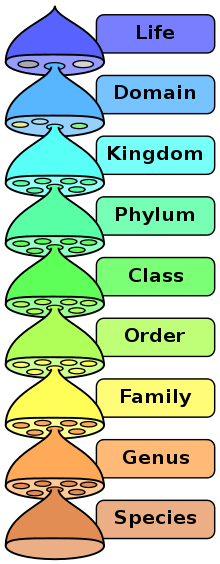Class (biology)
In biological classification, class (Latin: classis) is a taxonomic rank, as well as a taxonomic unit, a taxon, in that rank.[lower-alpha 1] Other well-known ranks in descending order of size are life, domain, kingdom, phylum, order, family, genus, and species, with class fitting between phylum and order.

Definition
The class as a distinct rank of biological classification having its own distinctive name (and not just called a top-level genus (genus summum)) was first introduced by the French botanist Joseph Pitton de Tournefort in his classification of plants that appeared in his Eléments de botanique, 1694.
Insofar as a general definition of a class is available, it has historically been conceived as embracing taxa that combine a distinct grade of organization -- i.e. a 'level of complexity', measured in terms of how differentiated their organ systems are into distinct regions or sub-organs -- with a distinct type of construction, which is to say a particular layout of organ systems.[1] This said, the composition of each class is ultimately determined by the subjective judgement of taxonomists. Often there is no exact agreement, with different taxonomists taking different positions. There are no objective rules for describing a class, but for well-known animals there is likely to be consensus.
In the first edition of his Systema Naturae (1735).[2] Carl Linnaeus divided all three of his kingdoms of Nature (minerals, plants, and animals) into classes. Only in the animal kingdom are Linnaeus's classes similar to the classes used today; his classes and orders of plants were never intended to represent natural groups, but rather to provide a convenient "artificial key" according to his Systema Sexuale, largely based on the arrangement of flowers. In botany, classes are now rarely discussed. Since the first publication of the APG system in 1998, which proposed a taxonomy of the flowering plants up to the level of orders, many sources have preferred to treat ranks higher than orders as informal clades. Where formal ranks have been assigned, the ranks have been reduced to a very much lower level, e.g. class Equisitopsida for the land plants, with the major divisions within the class assigned to subclasses and superorders.[3]
The class was considered the highest level of the taxonomic hierarchy until George Cuvier's embranchements, first called Phyla by Ernst Haeckel,[4] were introduced in the early nineteenth century.
Hierarchy of ranks below and above the level of class
As with the other principal ranks, Classes can be grouped and subdivided. Here are some examples.[lower-alpha 2]
| Name | Meaning of prefix | Example 1 | Example 2 | Example 3[5] | Example 4 |
|---|---|---|---|---|---|
| Superclass | super: above | Tetrapoda | Tetrapoda | ||
| Class | Mammalia | Maxillopoda | Aves | Diplopoda | |
| Subclass | sub: under | Theria | Thecostraca | Chilognatha | |
| Infraclass | infra: below | Cirripedia | Neognathae | Helminthomorpha | |
| Subterclass | subter: below, underneath | Colobognatha | |||
| Parvclass | parvus: small, unimportant | Neornithes | - |
Notes
- When the term denotes taxonomic units, the plural is classes (Latin classes).
- Not all ranks are used in every taxon
References
- Huxley, Thomas Henry (1853). Henfrey, Arthur (ed.). Scientific memoirs, selected from the transactions of foreign academies of science, and from foreign journals. Natural history. Taylor and Francis. doi:10.5962/bhl.title.28029.
- Mayr E. (1982). The Growth of Biological Thought. Cambridge: The Belknap Press of Harvard University Press. ISBN 0-674-36446-5
- Chase, Mark W. & Reveal, James L. (2009), "A phylogenetic classification of the land plants to accompany APG III", Botanical Journal of the Linnean Society, 161 (2): 122–127, doi:10.1111/j.1095-8339.2009.01002.x
- Collins, A.G., Valentine, J.W. (2001). "Defining phyla: evolutionary pathways to metazoan body plans." Evol. Dev. 3: 432-442.
- Classification according to Systema Naturae 2000, which conflicts with Wikipedia's classification. "The Taxonomicon: Neornithes". Retrieved 3 December 2010.